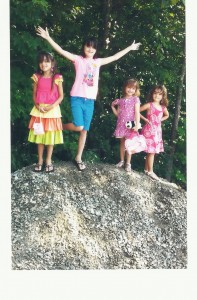 I had the pleasure of hosting my four great nieces at my home this summer for two months. How wonderful is a houseful of girls! A new experience for me with six boys. Coloring, drawing, and pretty creations were often the center of their chosen free time. The dollhouse, pretend food and kitchen, and LEGO inspired from The Lego Movie were favorite chosen play time objects. I was gifted many pictures and love sentiments by each girl. One activity self-initiated by each of the two older girls, ages 7 and 9, near the end of their stay especially caught my attention: original stories.
I had the pleasure of hosting my four great nieces at my home this summer for two months. How wonderful is a houseful of girls! A new experience for me with six boys. Coloring, drawing, and pretty creations were often the center of their chosen free time. The dollhouse, pretend food and kitchen, and LEGO inspired from The Lego Movie were favorite chosen play time objects. I was gifted many pictures and love sentiments by each girl. One activity self-initiated by each of the two older girls, ages 7 and 9, near the end of their stay especially caught my attention: original stories.
Why did it catch my attention? Because they perfectly represent the typical early writing styles of both the left-brained learner (the 7-year-old) and the right-brained learner (the 9-year-old). The first thing I noticed was how often the 7-year-old modeled her drawings and designs after her older sister’s creations. Left-brained people can be creative, but we often like to work from models. For instance, for knitting, I follow patterns very well and would have a hard time creating an original knitting project. My right-brained friends, however, tend to love creating their own designs, and can often find it frustrating to follow written instructions. Two different styles; two different strengths. I had to help the older sister accept the shadowing of her younger sister as flattery and a way to be a helpful older sister. I encouraged the younger sister to embrace her own style as valid even if it looked different from her sister’s. They each flourished individually with this direction.
The second thing I noticed was how they each responded to read-aloud time. The younger, left-brained sister liked sitting right up next to me and following along. With seven right-brained children, I have never experienced that! Initially, the older, right-brained sister had a hard time figuring out how to focus on a read-aloud. I knew from experience with my right-brained children, they needed to do some kind of creative pursuit while listening in order to actually be able to attend better. What’s happening is that they are “turning on the right side of their brain” to attend to a left-brained and/or passive activity (listening). Eventually, she settled into what could work for her…drawing or coloring.
That brings me to the stories that the 9-year-old wrote. Each girl would bring in several books to look at during the quiet time before bedtime. She had discovered an alphabet book and immediately began to directly copy that book into her own book. In school, “copying” is discouraged as cheating. I wrote a post about how my right-brained children showed me a very different face of copying as actually a form of mentoring. I could immediately give value to what she was doing. We also read many picture books during this time. One was called I’m Dirty. Several weeks later, my 9-year-old right-brained niece presented me with this story, inspired by this book:
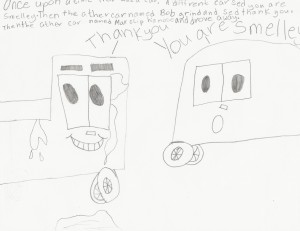
Once upon a time, there was a car. A different car said, “You are smelly.” Then the other car named Bob grinned and said, “Thank you.” Then the other car named Max clipped his nose and drove away.
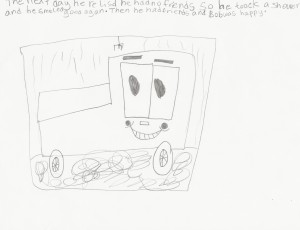
The next day, he realized he had no friends so he took a shower and he smelled good again. Then he had friends and Bob was happy.
Some of a right-brained child’s first stories are often inspired by other stories. Why? Because they see their story in their head all at once. It’s difficult when they are young to sort and organize an entire story that they see as a whole image into parts and sequences (the strength of a left-brained dominant person). An original story that requires this sorting and sequencing often begins in the 11 to 13 year range because that’s when both sides of the brain are fully integrated and they are more able to utilize the less dominant side of their brain. And, yet, the imagery that IS their strength is a perfectly valid gift! If we can recognize that as they are progressing through their natural developmental process, they can feel appreciated for what they offer in product in the younger years. By modeling from another story, a right-brained learner can piggyback off the author’s sorting and sequencing skills that they are not ready for yet to that level, and yet still create completely original plots, characters, beginning and ending. With great art to boot!
Some cool things to note in her story: How the drawings didn’t always show the entire character (shows she naturally understands the whole is implied and she chooses to create impact). How her text in the trash page was left with a (…) to again create impact. She learned to use different sized print for impact. My own personal cool observation…she reversed her J…same as my oldest son at her age, who is an artist. She also had an author page I didn’t include. All of these things indicate her understanding of good writing. We just have to recognize the same! Good stuff!
A week or two later, my younger 7-year-old, left-brained niece, presented me with her own story:
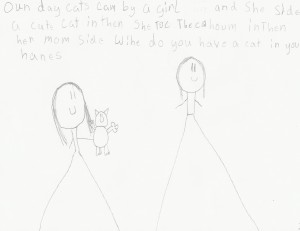
One day, cats came by a girl and she said, “A cute cat,” and then she took the cat home and then her mom said, “Why do you have a cat in your hands?”
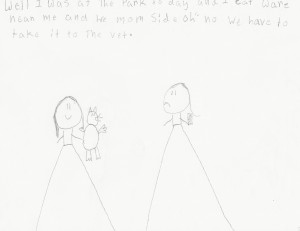
Well, I was at the park today and a cat was near me and her mom said, “Oh, no. We have to take it to the vet.”
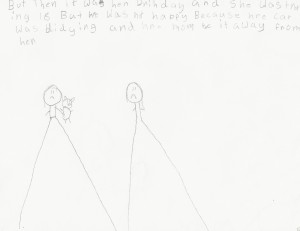
But then it was her birthday and she was turning 18. But she was not happy because her cat was dying and her mom took it away from her.
The foundational strengths of a left-brained learner is words and sequencing. Stories fall right into their wheelhouse. It’s normal for any child between the ages of 5 and 7 to engage in activities that use their foundational strengths based on their dominant side to process information. You will see young left-brained children engage in story-writing as one possible activity. Girls are pre-dominantly left-brained; boys are pre-dominantly right-brained. Even for right-brained girls, the left-brained girl gene can sometimes result in some left-brained activities at various stages.
My 7-year-old niece’s story is what we expect from writing when we ask our young children to write. But, this is one way to express your ideas. And it is a valid way. Some notes about her story: Do you notice all her “and thens, and thens?” That’s her sequencing skills coming out. I love how she picked out patterns already in writing stories with the vet scenes…it’s sick, why, answer, solution, it’s sick, why, etc. Then her personality comes out in declaring the vet to be wrong, and ultimately proving him so. She was at that stage of understanding when people were teasing her and teasingly declaring them wrong back and just overall realizing adults can be wrong. Good stuff!
Whether expressing stories utilizing the strengths and processes of left-brained dominance or utilizing the strengths and processes of right-brained dominance, it’s all good stuff!
What kind of idea expression does your child engage in: movie-making, comic book making, modeling from books, oral storytelling? What good stuff do you notice?

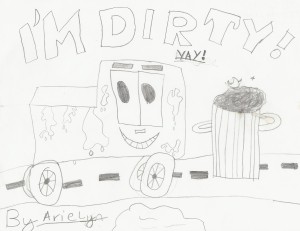
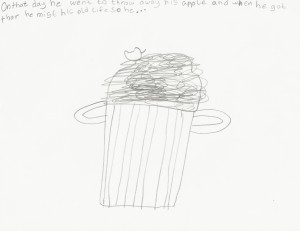
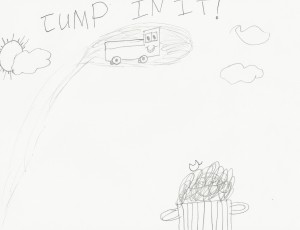
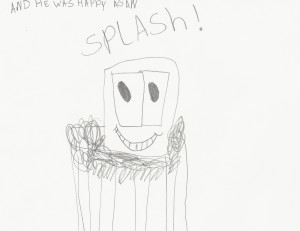
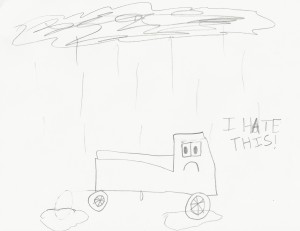
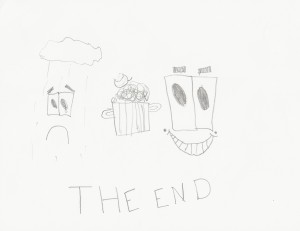
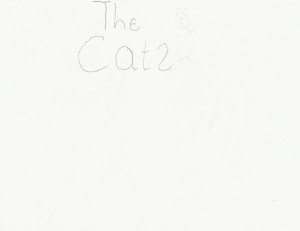
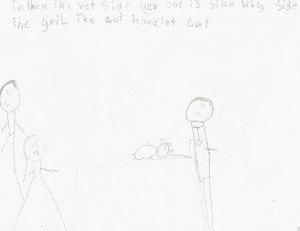
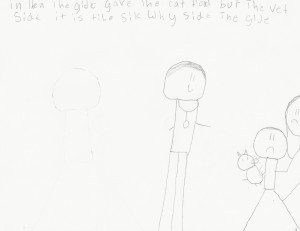
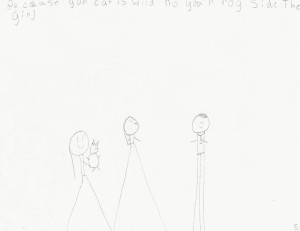
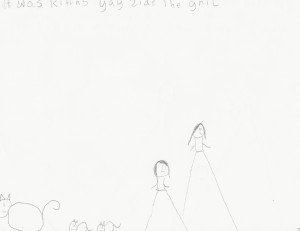
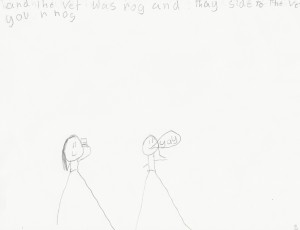





Pingback: All About Spelling | The Right Side of Normal
Pingback: Writing in the Teen Years – A Natural Progression |
Pingback: Writing in the Teen Years: The Mentored Path |